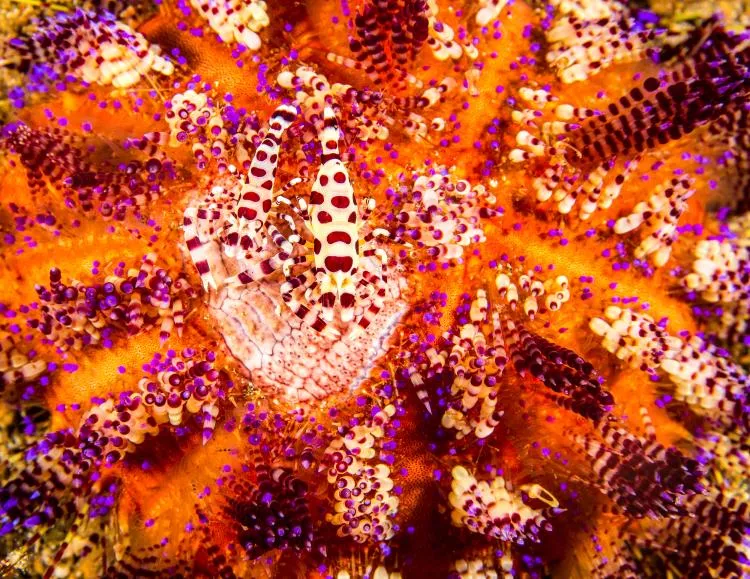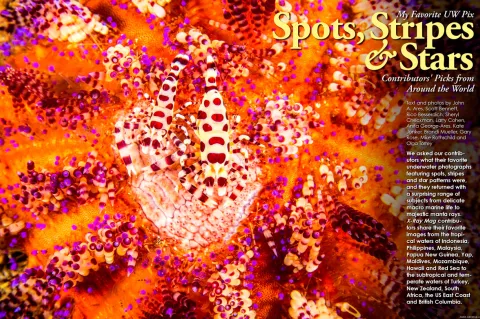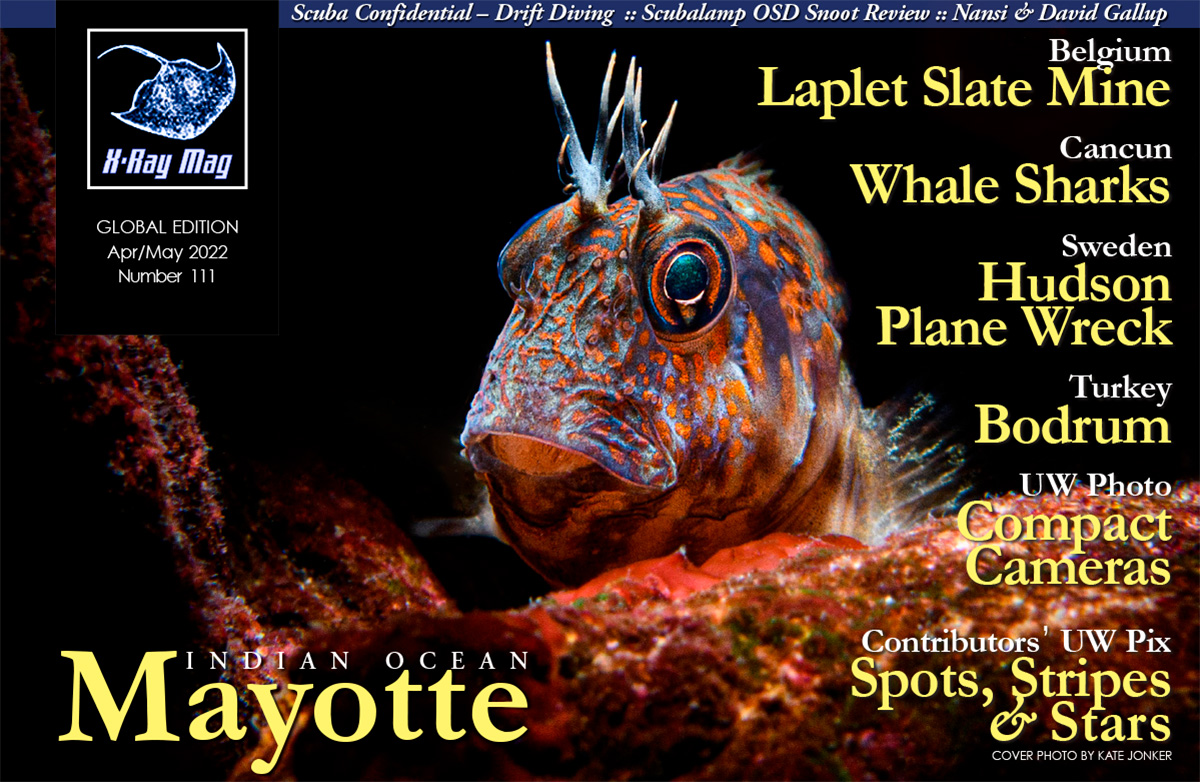We asked our contributors what their favorite underwater photographs featuring spots, stripes and star patterns were, and they returned with a surprising range of subjects from delicate macro marine life to majestic manta rays. X-Ray Mag contributors share their favorite images from the tropical waters of Indonesia, Philippines, Malaysia, Papua New Guinea, Yap, Maldives, Mozambique, Hawaii and Red Sea to the subtropical and temperate waters of Turkey, New Zealand, South Africa, the US East Coast and British Columbia.
Contributed by
(To see all the images in the article, please scroll down and download the PDF)
Telling a Story
Text and photos by Anita George-Ares
I have an insatiable curiosity. Underwater photography helps me identify the subjects in the images that I take. Regarding the creative process, I aim to tell a story while celebrating the uniqueness of marine life. I photograph species in their habitats, for that tells a story. I try to photograph behavior for that is another part of the story.
While I sometimes previsualize an image, and in the words of Sam Abell, “compose and wait,” things often happen quickly underwater. So, when I am back home, I use Lightroom and Photoshop to highlight compositional elements such as color and patterns. I sometimes discover another species, situation or pattern that I did not notice when I was taking the image.
Anilao’s Secret Garden dive site in the Philippines includes a relatively steep, muddy slope that has an amazing number of variable fire urchins with Coleman shrimp. I was drawn to the intense coloration of the fire urchin, the unique shapes and arrangement of its spines, with the bonus of shrimp! Shooting downward captured the interesting patterns. Because I moved in close while shooting, minimal cropping was used for the image.
Coleman shrimp are found in pairs and occur on only one or two species of fire urchin. Female Coleman shrimp are larger than the males. The colorful and venomous fire urchins provide protection for the shrimp. The shrimp neither benefit nor harm the urchin, which is an example of a commensal relationship. The shrimp occupy a cleared area that shows part of the urchin test or skeleton.
Crinoids, also known as feather stars, occur in many colors. The commensal crinoid shrimp are well camouflaged as they expertly match the colors and patterns of their host crinoids. I chose this image from Negros Island in the Philippines to illustrate how beautifully camouflaged this small shrimp was. In the original image, the shrimp and the crinoid arm were in a near vertical position. To improve the composition, I rotated the image 90 degrees and then cropped it. The image almost looks as if it has been converted to black and white. There is no color to distract from the repeating pattern of stripes and spots.
At a dive site in Puerto Galera, Philippines, I noticed the interesting pattern of spots and stripes on the Haeckel’s anemone, which varies in color. I like this image because the radial symmetry of the surrounding soft coral complements the radial pattern of the anemone. The image was cropped to make it more pleasing. The spots on the large tentacles are nematocysts (venomous, stinging capsules). This anemone species is typically found in sandy areas, where the anemone can withdraw completely into the sand.
In the image of the bubble coral shrimp taken at Anilao, the shrimp appears to be looking at the viewer. I like the bold stripes of the shrimp against the muted, striped pattern of the bubble coral. The image was significantly cropped. A few of the bubbles were overexposed. The adjustment brush tool in Photoshop was used to darken some of the overexposed bubbles. These commensal shrimp reside exclusively on bubble coral. Please visit: facebook.com/profile.php?id=100016947967639
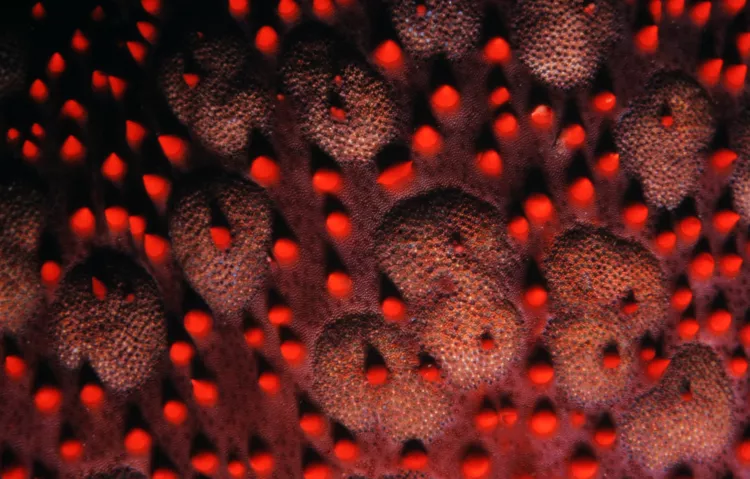
Rewards of Identification
Text and photos by John A. Ares
The image of the cushion sea star in the Maldives was shot on film and digitized. The sea star was loaded with spots! I thought getting very close would isolate the elements of the sea star. Using a single strobe held at a low angle would accentuate the contrast and add depth.
For me, part of the rewards of underwater photography is identifying what I photograph. Since studying marine sciences in graduate school, my wife and I have collected an extensive library on species identification and behavior. So, I picked out the book, Reef Creature Identification—Tropical Pacific by Humann and DeLoach, for a reference. If you have a general idea of what a particular creature might be, searching a reliable identification book for it beats scrolling through thousands of potentially misidentified internet images.
I loved shooting these catfish at Dumaguete in the Philippines. I think I may hold the world record for the largest swarm of catfish in a photo, which was published in Aqua—International Journal of Ichthyology, 2011. Estimates by graduate students pegged the number of the huge swarm in my photo at over 2,700 fish!
Striped coral catfish are common in the Indo-Pacific. During the day, the juveniles hunt together. The adults come out at dusk or night. The catfish have venomous spines on their dorsal and pectoral fins, so they should not be touched.
Shooting down on them was a different approach for me. I usually try to get low in order to get their “Roman soldier” rotating charge in front of me. Since they are black and white in color, converting the color photo to black and white was a natural choice.
Many nudibranchs are just plain gorgeous, like the Armina occulta nudibranch I photographed in Dumaguete. There are entire websites devoted to nudibranchs, in addition to a Facebook page and books. I learned years ago that in the Indo-Pacific, one should stick with the dive guides who will find you creatures. So now, I give dive guides a list of what I am looking for and I get a higher success rate of new creatures to photograph, in contrast to the dives when guides just point out a common Chromodoris annae for the hundredth time. For me, the square format works better for many pictures. I got used to shooting in this format while using a Hasselblad film camera.
To photograph the crown-of-thorns sea star in Dumaguete, I approached it from a side angle and placed the strobes low and to the side, to create a bit of drama. The square format and black-and-white photography seemed a natural choice again for this shot. Crown-of-thorns sea star have venomous spines, so care needs to be taken when photographing them. In some areas, they help maintain coral reef balance as they eat fast-growing corals. In other areas, because of their ravenous appetite, their populations need to be controlled. Visit: JohnAres.com
REFERENCES:
Gosliner, T., Valdes, A., & Behrens, D. (2015). Nudibranch and Sea Slug identification–Indo-Pacific. New World Publications.
Humann, P., & Deloach, N. (2012). Reef Creature Identification–Tropical Pacific. New World Publications.
Nudibase. https://www.facebook.com/groups/nudibase
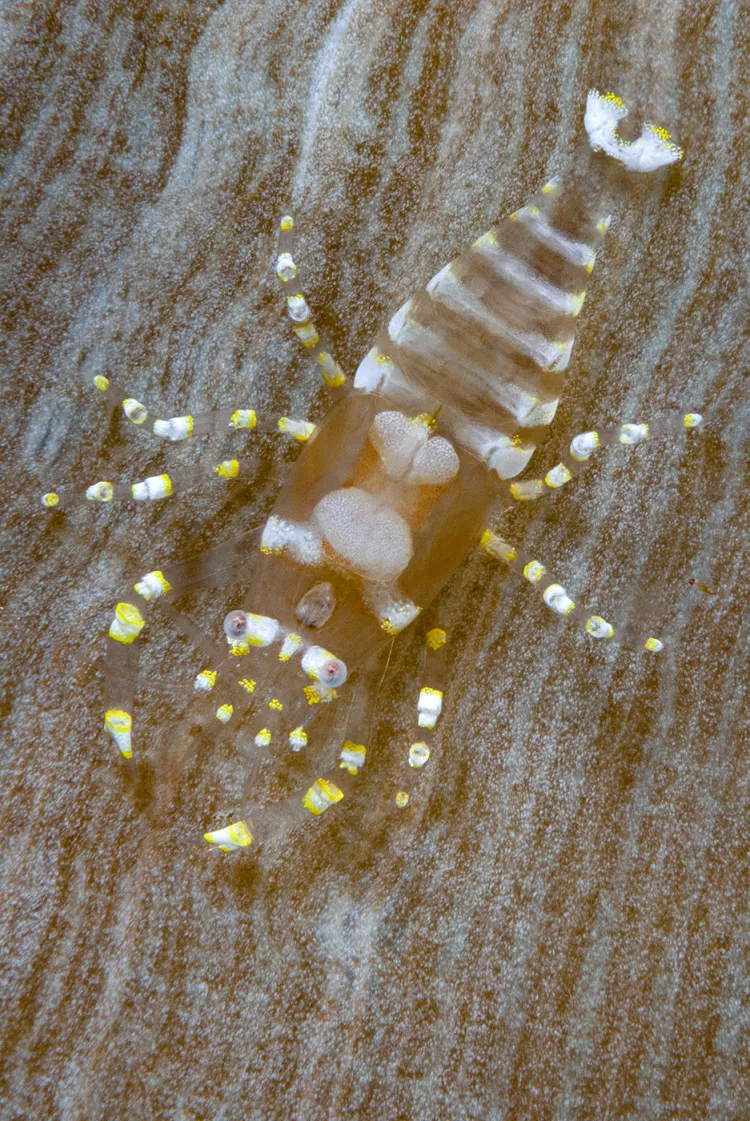
Critters that Crawl or Slither
Text and photos by Scott Bennett
Regarding spots and stripes, there is no better subject than ghost shrimp. While on a liveaboard trip to Papua New Guinea’s Kimbe Bay, I encountered this specimen on a disc anemone. Beautifully patterned with white bands and yellow spots, the transparent body was virtually invisible, creating dramatic contrast. The anemone provided additional stripes, and the image was shot with the subject and background on a diagonal to lead the eye.
During a dive to photograph Cape fur seals in Cape Town, South Africa, things were not going according to plan. Lightning-fast seals and poor visibility proved frustrating, so I concentrated on the reef itself. The colours and textures were amazing, but it was the spiny sea stars that captivated me. The reef was literally swathed, a mass of twisted bodies and knobby textures. Using a wide-angle lens, I moved to fill the frame, with the reef adding a splash of contrasting colour.
New Zealand’s Poor Knights Islands are a meeting ground of temperate and tropical species, and home to a plethora of unique species. Nudibranchs are a personal favourite and none more so than this sweet ceratosoma. Following one’s progress, I waited for it to traverse a patch of yellow bryozoans. The white body provided contrast, with its yellow spots echoed in the background, drawing in the viewer’s eye.
Situated off Bali’s northeastern coast near Tulamben, Seraya Secrets is a fantastic macro site and home to a dizzying array of critters. This zebra moray was encountered on a night dive as it patrolled the volcanic substrate in search of prey. It finally settled, its upper body protruding from beneath a piece of wood. The undulating curves and vertical stripes created a striking contrast against the dark sand. Visit: xray-mag.com/Contributors/Scott-Bennett
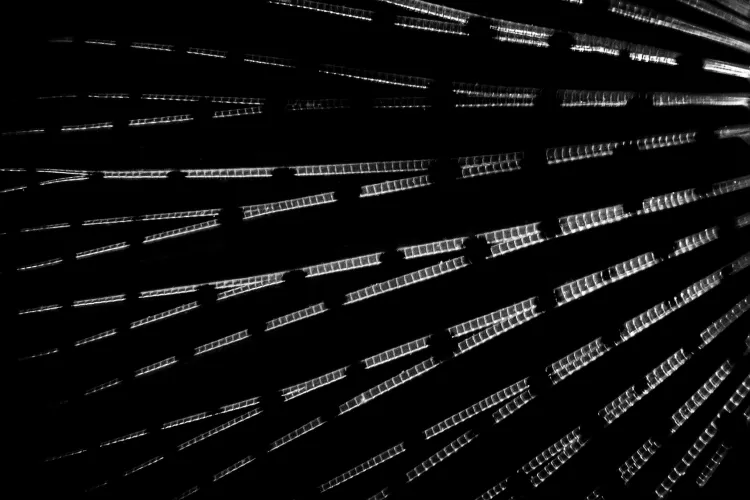
Revelling in Abstractions
Text and photos by Rico Besserdich
As I have always been a fan of abstract underwater photography, I often look for interesting patterns and shapes during my dives. The photo Abstract Fin is an abstract image of a lionfish’s dorsal fin. I enjoyed reducing the subject to its very core: the beautiful stripes inside the fish’s fin.
Whenever I conducted underwater photography workshops in the Red Sea, I always tried to arrive a bit earlier (before the participants did) and have a day for myself, snorkelling the shallow bay of Na’ama Bay, looking for patterns, shallow underwater scenes, and anything else that was interesting to spot. The image Ocean Floor was taken while freediving. It is one of my all-time personal favourites, because it displays the peace and harmony of the ocean so nicely. Also, I loved the stripes and patterns the sunlight drew on the ocean floor.
Tubeworms (Sabella) can be seen very often in the Mediterranean Sea of Turkey.
Having a very close look at them (if they let you—often, they just hide in their tubes) shows their special beauty, which not only consists of beautiful colours and fine gradients but also, perfect stripes. Again, I like abstractions. Therefore, I like to go incredibly close to common subjects (if they let me), discovering their finest details with my camera. Visit: maviphoto.com
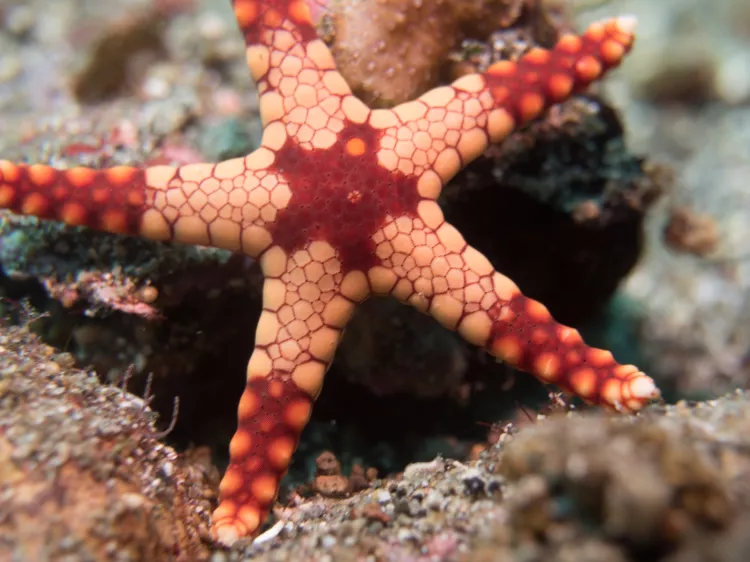
Vibrant Patterns of Alor
Text and photos by Sheryl Checkman
In 2017, I dived off the island of Alor in Indonesia and was blown away by patterns in the sea more vibrant than I have seen in the Caribbean—from the freeform turquoise-stripes on the orange body of a mandarinfish—to the evenly spaced, black-and-white, candy-cane stripes of a sea snake.
Never having encountered one before, I must have followed the snake for a good ten minutes as it weaved its way along the reef, its black and white stripes a sharp contrast to the reef beneath it. It was only later that I learned how poisonous this snake was.
At Bakalong Jetty, a black crinoid spread its star-like arms against a pale pink coral sea fan. The fine, feathery lines that make up its arms, as well as the dark lines of the jetty itself, contrasted with the branched pattern of the sea fan.
I also encountered many different types of starfish with varied textures and colors. One in particular had an interesting pattern of geometric shapes on the inner part of its cream-colored body, with the tips of its arms a deep orange, as if they had been dipped in paint.
Another purple-toned sea star (Linckia laevigata) spread itself out against the pink-toned reef as if to say, “This is mine!” If you look closely, you can see a pattern of darker spots, adding subtle texture to its arms. To see more, click the photo tab at: checkmandesign.com.
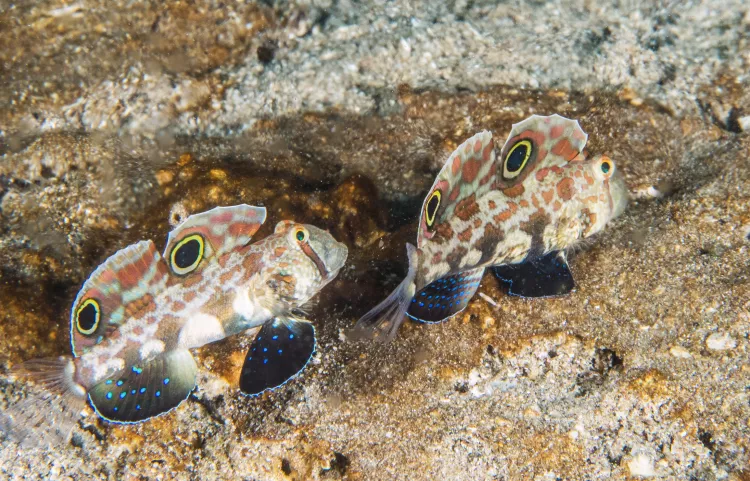
From the Defensive to the Comical
Text and photos by Larry Cohen
As an underwater photographer, I am always on the lookout for marine life with patterns that might include spots or stripes. These patterns are pleasing to the human eye, but their purpose could be for mating, as warning signs, or for defense purposes.
In the case of the yellow boxfish, the spots and yellow color is a warning sign. When this beautiful fish is stressed, it releases the neurotoxin tetrodotoxin (TTX) from its skin. This is deadly to fish in the surrounding waters (Wikipedia.org). Trying to keep this tiny, fast-moving fish in the camera’s frame as it quickly moved in front of me was difficult.
Diving Mataking House Reef Pier on Pom Pom Island in Malaysia was an exciting shore dive with a strong current. Marine life was abundant under the pier, including a school of juvenile golden batfish. These fish have an engaging vertical stripe and seem to relish being photographed. They stayed still in the water column while I struggled to keep my position in the current.
Underwater photographers can easily stay engrossed, documenting the variety of sea stars in Papua New Guinea. I spotted a brittle star crawling across the seafloor when diving Dicky’s Reef. I found it interesting that this star has a tiny central body surrounded by long flexible arms used for locomotion.
When diving below the dock at Tufi Resort, I was entertained by watching two twinspot gobies. These fish are absurdly comical as they hop along the bottom. They travel in pairs; and to their predators, their twin spots look like eyes on a much larger fish. Visit: liquidimagesuw.com
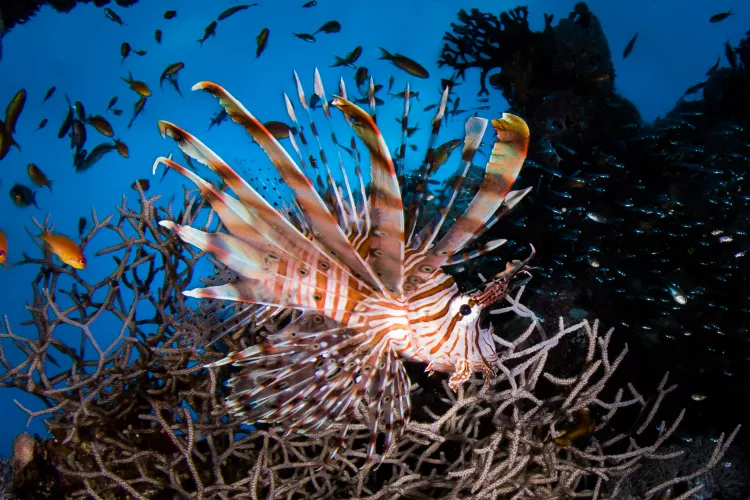
Contrast of Patterns
Text and photos by Kate Jonker
Spots, stripes and stars can be found in many different forms underwater, from markings on marine animals, to abstract textures on the reef. As an underwater photographer, I am drawn to the contrast of these patterns. But why do they exist? Do they serve a purpose?
Spots are often used to hide the location of a fish’s eye, making it difficult for predators to predict the direction its prey will swim in when it tries to escape. Spots can also camouflage animals, making them harder to find on the reef. Stripes can break up the outline of a fish, making it less visible to potential predators.
Other creatures, especially nudibranchs, use colourful spots and stripes to warn other marine animals that they are toxic and not good to eat. On the other hand, some animals use their brightly coloured spots and stripes to attract their next meal—or a mate.
Over and above the many beautiful starfish we find in our oceans, natural star shapes can be seen in the formation of our corals and even in the polyps of soft corals. Not only do spots, stripes and stars serve a purpose to their owners—be it protection or attraction—they also provide divers with wonderful opportunities to create striking images underwater! Visit: katejonker.com
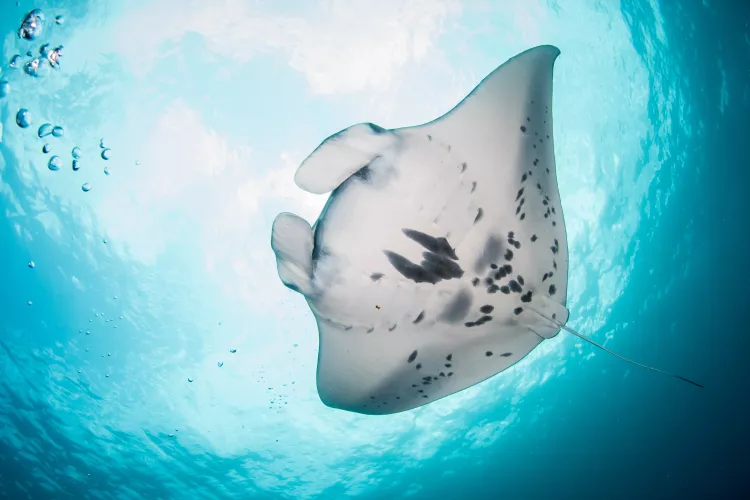
Manta Spots
Text and photos by Brandi Mueller
Every manta ray has a unique pattern of spots and stripes on its ventral side, which can help us identify individual animals. Early in my dive instructor career, I worked for several years around Kona in the US state of Hawaii where one of the first manta identification programs was started.
Many years ago, a hotel put lights out on the ocean for decoration, and the light attracted plankton and then mantas, which came in to eat the plankton. Since then, they have moved the “dive site” north of Kona, and every night, mantas come in to feed on a free buffet of plankton attracted by the divers’ lights.
Diving this site over and over again, I started to recognize mantas, many of which were named. I have been lucky to dive with mantas all over the world, and these photos show several individuals from Kona, Indonesia, Yap and the Maldives.
Any diver can become a citizen scientist and submit photos of mantas’ spots and stripes to the databases, such as mantamatcher.org, to help researchers learn more about manta populations and behaviors. Please visit: brandiunderwater.com
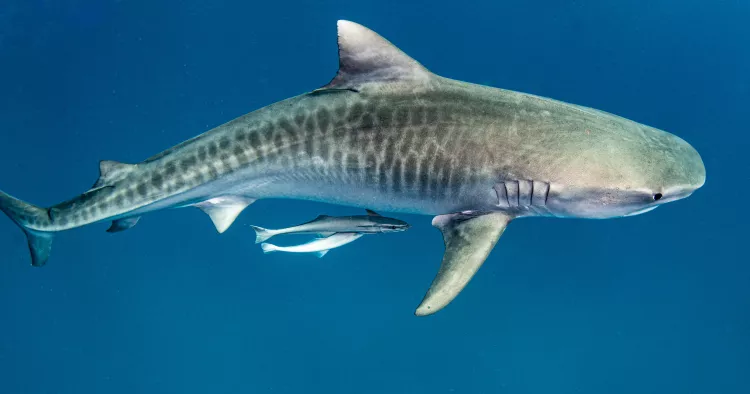
Starring Sharks
Text and photos by Gary Rose, MD
Perhaps like many underwater photographers who are asked to consider the theme “spots, stripes and stars,” I immediately summoned up visions of the living reef with shoals of fish rhythmically moving with the gentle surge of the sea. We have all seen thousands of photographs with the myriad of patterns and colors that our coral reefs have to offer—a photographer’s dream. Rather than repeating this notion with my own repertoire of reef photos, I decided to share with you the “spots, stripes and stars” found far offshore, in the deep blue water column.
Bars and Bands is a photo of Patrick, a young male tiger shark, who is a frequent visitor to the local water column off the US East Coast. The image beautifully demonstrates the transitioning of “young bars” to “maturing stripes” on tiger sharks. There is nothing like the thrill of swimming with tiger sharks and observing their slow serpentine propulsion.
The photo, Sun Dappling Light Patterns, very clearly captures the beauty of natural sunlight creating an abundance of visual light effects. I love to watch the lemon sharks follow divers to the surface and play with small pieces of sargassum seaweed. The added benefit was the wave patterns that formed on their reflective skins.
Bands of Light is a photo rulebook no-no: “Never shoot down,” they say. To capture this panoply and admixture of light, I chose to shoot straight down through the dark-blue water column. This special effect of the light rays, seemingly emanating from this lemon shark, is one of my favorites. Visit: garyrosephotos.com
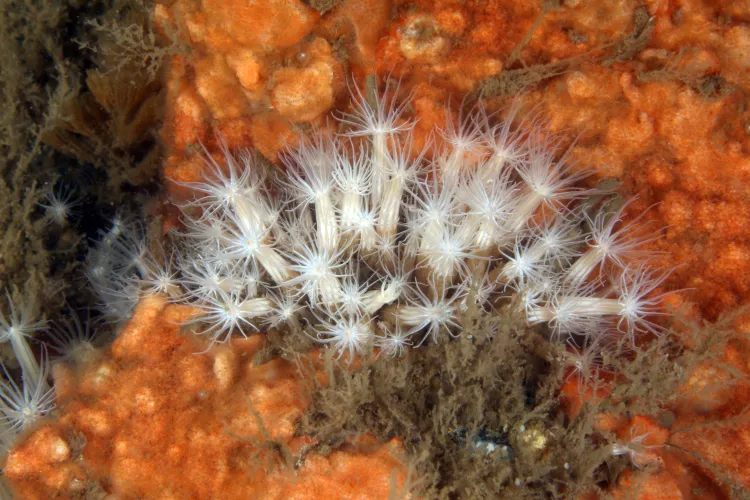
Finding the Perfect Fit
Text and photos by Michael Rothschild, MD
The image of the crab is from one of my favorite local dives near my home in New Jersey, a shallow site just off the shore, underneath a bridge. The spots of the crab’s high-key shell contrast nicely with the dark bed of mussels.
The lined anemone photographed on the Cadet wreck is common coverage on our local shipwrecks. The stripes on the shaft and the stars on top seemed to be a perfect fit for this assignment. I especially like the way the bright orange background makes the white polyps pop out, giving the image a 3D effect.
Finally, the banded rudderfish have some of the most prominent stripes in our part of the ocean. These fish—a type of small jack—get their name from their habit of following the stern of ships near the surface. I found this group swimming under the propellers of our dive boat. Visit: dive.rothschilddesign.com
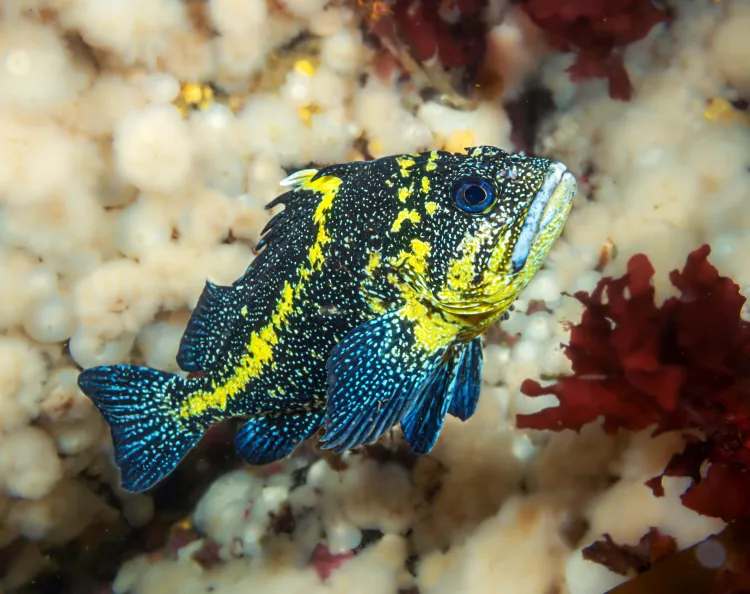
Stars of British Columbia
Text and photos by Olga Torrey
As a wildlife photographer, I find patterns, color and texture of the subjects essential. I bought my Olympus OM-D E-M5 camera in 2013, and right after, I flew to British Columbia, Canada, to dive off the liveaboard Swell Explorer around Vancouver Island.
British Columbia’s top dives are in the northeastern corner of Vancouver Island. Browning Passage is the place for underwater photography. This location is rich with bright colors of soft raspberry corals, yellow sulfur sponges, white plumose anemones, sea stars, nudibranchs, red urchins and many other creatures you will see on the walls. This place is excellent for macro and wide-angle photography.
The China rockfish (Sebastes nebulosus), or yellow-spotted rockfish, is the right subject for this theme. The primary color yellow is a distinguishing feature of the yellow stripe that runs along the primary blue or black body of the fish, from near the third dorsal-fin spine, and extends to the lateral line and to the tail. If you want to photograph a giant pacific octopus, China rockfish are a good indicator, since they live in the same rock crevices.
The orange ochre sea star, with its vibrant color in contrast to the bright color of green surf anemone, is in the same group of secondary colors. Primary colors red and yellow make orange, and primary colors yellow and blue make green.
The ochre sea star is a perfect subject when it comes to color. This star comes in two vibrant secondary colors: purple and orange, and the tertiary color brownish-red. Scientists wonder if the color of the ochre star is caused by habitat, diet or genetic variation. The mystery of its color puzzle still needs more scientific research. These two stars remind me of the Henri Matisse painting, La Danse (The Dance).
With its vivid body coloration mixed in primary colors yellow and blue, kelp greenling stands out among the fishes in British Columbia. The eyes of the kelp greenling are mesmerizing with vibrant yellow color. The coloring of the male and female is distinct. This photo shows a male with bright blue spots on his head and sides. The female has reddish-brown to bright golden colors. Visit: fitimage.nyc

